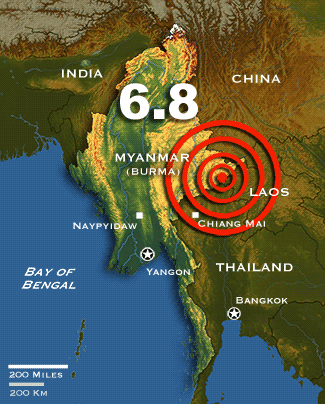It seems every couple days there is another earthquake punching holes in the topography of Asia, and across the world too. Zhuhai, where I’m currently living, also has shaken a few times in the past year. I hadn’t felt a tremor before 2010 and nothing like it had happened in this city since I got here in 2006. It was an unusual wobbling which lasted a few minutes… maybe the kind of nauseating shake that Californians are used to… Across the Pearl River Delta, in Shenzhen and Hong Kong, a 2.8 magnitude jolted the area in November of 2010 [*]. What’s strange is that this area is not considered to be on any kind of fault line.
With friends in Taiwan, The Philippines, and Japan, the recent earthquakes have added worry and frustration to many people I know there. (Keep them in your thoughts and prayers, if you are into that kind of thing.) It could be the media reports have come to my attention more recently, or it could be an increase in plate-shifting, or maybe 2012 as my students suggest… Although we can’t be sure, the consistency of recent earthquakes is a little disturbing. Yesterday, March 24, a 6.8 hit Burma and Thailand; March 22, a 6.1 hit the Philippines and Taiwan in the same day; Japan was hit by a 9.0 on March 11; Myanmar got a 5.4 on March 10; Papua New Guinea got a 6.5 on March 9; Japan got a 7.2 on March 9; a few Pacific island countries got 6.0 or higher in March too [*]… and those were just this past month! February counted over twelve 6.0+ magnitude earthquakes around Asia.
Earthquakes aren’t rare and the link above compares the amount of earthquakes occurring annually around the world. Japan, Taiwan, and The Philippines are positioned directly over a major fault line, which is doesn’t make the recent events too surprising. A major earthquake is bound to happen! Take a look at all the locations of earthquakes in Taiwan since 1990.
When I post in my Chinese social networks, like QQ and Renren Wang, I find that people are talking about this phenomenon too. They are saying that the “world is on vibrating mode”, like a mobile phone setting. Perhaps it is, or maybe it’s just the randomness of the planet Earth.
How big can the aftershocks get? (April 7, 2011 NPR.org)
“Large earthquakes have more, larger aftershocks,” says Volkan Sevilgen, [an earthquake researcher with the U.S. Geological Survey]. “The basic rule is if you have one magnitude 9 earthquake, you can have 10 magnitude 8s, 100 magnitude 7s, and a thousand magnitude 6s.”
Some earthquakes follow this pattern very closely; others are more random — it’s all a matter of probability. Since the March 11 earthquake, there have been about 400 aftershocks greater than magnitude 5, and three over magnitude 7. Sevilgen says the 7.1 magnitude earthquake [in Japan] reported on the morning of April 7 is no surprise.
NOTE: I’ll be updating this post as the rest of this Spring unfolds.

Related posts:
- High Speed Rail Around Asia High Speed Rail (HSR) is not new to Asia, although the biggest network is now being constructed in China. HSR...
- Tibetan New Year in 2011 What we learned from our guide and how he perceives life in Tibet with the top 2 spiritual leaders in...
- Expat Blogging in Asia AsianLiving.ME is not really an expat site, although expats can find it useful. The health, lifestyle, and cooking tips are...
- Don’t Donate Money to Japan? Cash Donations Post-Disaster A clever writer at Rueter’s stirred up controversy recently with an opinionated article titled “Don’t Donate Money...
- Japanese Radioactive Rain In the past few days, since the earthquake/tsunami crisis in Japan, a lot of rumors have spilled over into the...



 Contact Me: ben@asianliving.me
Contact Me: ben@asianliving.me